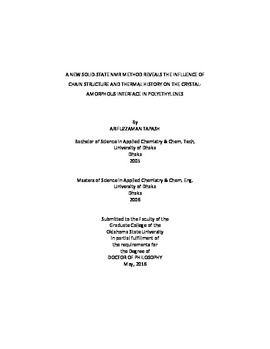| dc.contributor.advisor | White, Jeffery L. | |
| dc.contributor.author | Tapash, Arifuzzaman | |
| dc.date.accessioned | 2017-02-22T22:12:07Z | |
| dc.date.available | 2017-02-22T22:12:07Z | |
| dc.date.issued | 2016-05 | |
| dc.identifier.uri | https://hdl.handle.net/11244/48952 | |
| dc.description.abstract | Clear understanding of polymer morphology is important as it is directly related to the final properties. A simple solid-state NMR method is presented in this contribution to quantitatively determine the distribution of solid polyethylene chain segments in different morphological regions. The rigid chain in the crystalline phase with all-trans chain conformations, the non-crystalline (amorphous) mixed trans-gauche chains undergoing essentially isotropic reorientation, all-trans chains with higher mobility (mobile all-trans), and non-crystalline chains with limited mobility (constrained amorphous) fractions were reliably quantified using a new double-acquisition solid-state 13C NMR experiment. A wide range of well-characterized PE samples was studied, which reveals that the amount of interface region increases with the chain length of linear metallocene-PE. Topologically different polyethylenes that contain short-chain branches (SCB), long-chain branches (LCB), and LCB's with SCB's exhibit unique morphological behavior relative to the linear PE's of similar Mw. The method also reveals the variations in morphology due to different thermal histories. Thermally quenched polyethylene was found to have higher interface content than that of the annealed or untreated PEs. Phase composition results obtained by this simple experiment are quantitative, reliable and reproducible as all of the data was collected in a single experiment. The results suggest a route to large-scale design and control of interfacial morphology in polyethylenes and related properties. | |
| dc.description.abstract | In a separate project, a 1H NMR experiment based on slow/fast magic-angle spinning (MAS) and a spin-counting strategy are presented to quantitatively determine the amount of soft and hard phase of styrene-butadiene gradient copolymers in component specific resolution. The experiments provide bulk rigidity and the amount of polybutadiene (or polystyrene) partitioned into both soft and hard phases. It was found that the partitioning of each comonomer depends on the synthesis conditions and we propose that the hard-soft interface is responsible for the differential partitioning. | |
| dc.description.abstract | Both experimental methods presented here can also be used to study different polymer systems. | |
| dc.format | application/pdf | |
| dc.language | en_US | |
| dc.rights | Copyright is held by the author who has granted the Oklahoma State University Library the non-exclusive right to share this material in its institutional repository. Contact Digital Library Services at lib-dls@okstate.edu or 405-744-9161 for the permission policy on the use, reproduction or distribution of this material. | |
| dc.title | New solid-state NMR method reveals the influence of chain structure and thermal history on the crystal-amorphous interface in polyethylenes | |
| dc.contributor.committeeMember | Blum, Frank D. | |
| dc.contributor.committeeMember | Nelson, Toby L. | |
| dc.contributor.committeeMember | Weaver, Jimmie D., III | |
| dc.contributor.committeeMember | Whiteley, James Robert | |
| osu.filename | Tapash_okstate_0664D_14523.pdf | |
| osu.accesstype | Open Access | |
| dc.type.genre | Dissertation | |
| dc.type.material | Text | |
| thesis.degree.discipline | Chemistry | |
| thesis.degree.grantor | Oklahoma State University | |
